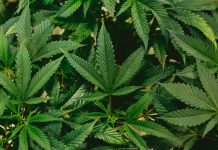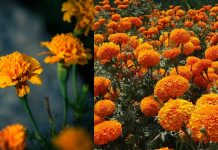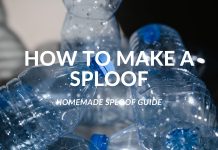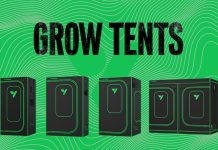A question we hear often is, “How far away should lights be?” It is a tricky question that can lead to hours of research and perhaps more uncertainty than when you started, but we are here to help! From our experience in the lighting industry, we have a few different questions we’ll need to consider along our path to figure out the best answer. Strap in, because this will be a long article!

Why does Light Height Matter?
Light Intensity: The distance between the light source and the plant canopy directly impacts the intensity of light that reaches the plants, which is referred to as PPFD (Photosynthetic Photon Flux Density). As the lights are raised, the PPFD decreases exponentially. This may result in inadequate light for achieving optimal growth.
Uniform Coverage: The appropriate height of the light ensures uniform and consistent coverage across the entire plant canopy. Lights positioned too high create shadows and uneven light distribution, resulting in irregular growth patterns.
Heat Management: Many grow lights produce considerable heat. Hanging them too close to the plants can cause heat stress, leaf bleaching, and other heat-related problems.
Stretch Prevention: If the lights are positioned too high, the plants may exhibit stretching – elongated internodes and thin, spindly stems as they try to reach for the light. This can compromise plant structure and yield.
Flowering Transition: For the flowering stage, lowering the lights closer to the canopy can help trigger the transition from vegetative to flowering growth by providing a stronger light signal.
Simply put, the more light a plant can have the better! More light means better yield but having your lights too close to your plants will cause a number of issues—a burn on the leaves that could appear like a nutrient deficiency, or if your lights are too far away you’ll encourage stretching of the stems, which uses up valuable resources that could go towards flowering.
Cannabis Light Distance Chart
| Stages | Distance |
| Seedlings |
|
| Vegetative |
|
| Early Flowering |
|
| Late Flowering |
|
Different Kinds of Lights
There are three kinds of grow lights commonly used by growers today: LED, HPS/MH/CMH, and Fluorescent. Each lamp has a different combination of heat output, light spectrum, and power usage. Heat output and spectrum are both keys for deciding where to put your lamp.
What Is PAR?
PAR stands for Photosynthetically Active Radiation, and it refers to the specific wavelengths of light that plants can utilize for the process of photosynthesis. It includes the visible light wavelengths between 400-700 nanometers (nm) on the electromagnetic spectrum. This range encompasses the blues, greens, yellows, oranges and reds that plants absorb and convert into energy.
How To Measure PAR?
| Stages | Description |
| Seedling Stage |
|
| Vegetative Stage |
|
| Flowering Stage |
|
What is PPFD, and Coverage?
PPFD stands for Photosynthetic Photon Flux Density, and it’s a critical metric for measuring the intensity of light available for photosynthesis during cannabis cultivation. It specifically quantifies the density of photosynthetically active radiation (PAR) photons hitting a given area, measured in micromoles per square meter per second (μmol/m²/s).
How To Measure PPFD?
| Stages | Description |
| Seedling Stage |
|
| Vegetative Stage |
|
| Flowering Stage |
|
Cannabis PPFD chart
| Stages | Description |
| Seedling Stage |
|
| Vegetative Stage |
|
| Early Flowering |
|
| Late Flowering |
|
We use PAR and PPFD to describe the part of the light spectrum that is usable by plants and is able to be converted into energy by photosynthesis. PPDF stands for Photosynthetic Photon Flux Density, which measures the amount of Photosynthetically Active Radiation (PAR) put out by a power source, be that your grow light or the sun. The closer your light is, the higher the PAR intensity will be, while the coverage will be much smaller.
In the perfect world, you would be able to coat each leaf with 100% of the light emitted from your lamp, but that of course just isn’t possible. PAR and PPDF are usually mapped on a chart such as this one, which displays the PAR values at different heights:
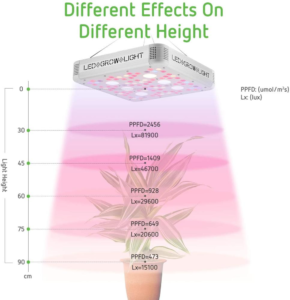
Here we can see how height affects the amount of “light” that reaches the plant below.
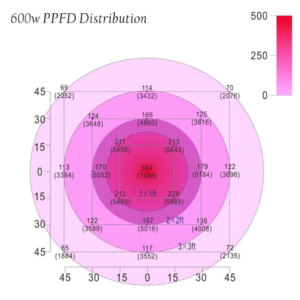
LED LIGHTS – How far away should grow lights be
LED grow lights are an excellent option, they are extremely dependable, long-lasting, and are a lot less of a burden on your electricity bill. Great choice! Yet, distance is probably the trickiest thing with LED lamps, as there is no right or standard distance from the plants, and the best distance varies by both lamp and wattage.
With our LEDs, we recommend that you keep your lamp at least 12 inches above the canopy. Here is a handy chart:
| Product | Nearest distance (in inches) | Furthest distance (in inches) |
| VS1000 | 12 | 24 |
| VS2000 | 12 | 36 |
| VS4000 | 18 | 46 |
| 300W LED | 12 | 36 |
| 1200W LED | 18 | 46 |
We recommend that you keep a minimum 12 inches distance between your plant and your canopy. Other growers may tell you they have had different results placing the lamp close to the canopy, but we cannot speak for them and everyone will eventually develop their own style of growing, so as a baseline, we strongly recommend not putting the LED closer than 1 foot.
This is because, while LEDs do not give off the heat of HPS or CMH bulbs, they still are able to cause “Sunburn” on your plant, which will over time reduce productivity and potentially kill your baby!
LED Grow Light Distance Chart
| Stages | Description |
| Seedling Stage |
|
| Vegetative Stage |
|
| Flowering Stage |
|
High-Pressure Sodium – How far away should grow lights be
HPS is another popular lighting system that we have received many questions about. Most new growers can tell that HPS systems should not be placed too close to a plant because of the amount of heat that emits from the bulb, however, there is a lot of debate about how high you should hang your bulb above your canopy. As with LEDs, one grower may have very different results from your own, so experiment and see what works well for you!
In general, our commercial grower partners often start by hanging their HPS lamps about 20—26 inches above the canopy and as they watch their plants they can see whether to adjust the lamp height or not. A telltale sign of needing to lower the lamp includes stems stretching and too few new buds and leaves being produced.
Another classic trick to judging whether the lamp is too close to the canopy is to sit your hand directly on the canopy and wait for 30 seconds. If your hand gets too hot so as to be painful, your lamp is too close.
We sell HPS bulbs as 1000W, 600W, and 400W.
Ceramic Metal Halide – How far away should grow lights be
CMH bulbs are another popular choice of grow light and have been on the market for many years. CMH bulbs, however, run much hotter and are more prone to burning plants. We recommend that you place these bulbs around 24 inches above your canopy. This will reduce leaf stress.
Fluorescent Bulbs – How far away should grow lights be
Fluorescent grow lights are comparatively weak in terms of PAR and heat output. Our T5 bulbs are mainly designed for low-light plants that grow under heavy forest canopies and normally are not used for most indoor plants, but with the right planning and knowledge, fluorescent bulbs can produce excellent results.
That said, keep fluorescent bulbs as close to your plants as you can (without burning them)! Your plants can handle it and your bulbs will probably never get hot enough to cause any worry! Big harvests can happen with fluorescent bulbs!
Reach out to a community! There are dozens of online and local communities revolving around your plants and will most definitely be able to help you decide the particulars of your grow. You will see that there are a lot of different ways to be a successful grower and with all of the equipment you can find on the market, growing large yields has become easier than ever.
Hanging your lights is just the first step in great grow, you’ll also want to research into training your plants, keeping the right nutritional balance, and developing automated environmental systems.
Autoflower light intensity
| Stages | Description |
| Seedling Stage |
|
| Vegetative Stage |
|
| Flowering Stage |
|
More Information about Light Distance and Light Intensity:
How Far should Seedlings be from Grow Light ?
What’s the Best Grow Light? Unveiling the AeroLight Revolution by VIVOSUN
What You Need to Know About Grow Lights?
How Many Grow Lights Do You Need?
Why Should You Choose the VIVOSUN LED Grow Light?
If you have any questions, please don’t hesitate to reach out to us!
And be sure to check out our other blog posts for useful tips on becoming a great grower!
Subscribe to the VIVOSUN newsletter for growing tips, grower stories, and special offers, and get 12% off your first order!
We love the new VIVOSUN Smart Grow System and we are certain that you too will love it once you try it.
And join our Facebook farmer’s community for even more exclusive contests and prizes!
Download VIVOSUN App to get 18% off and explore more information!



